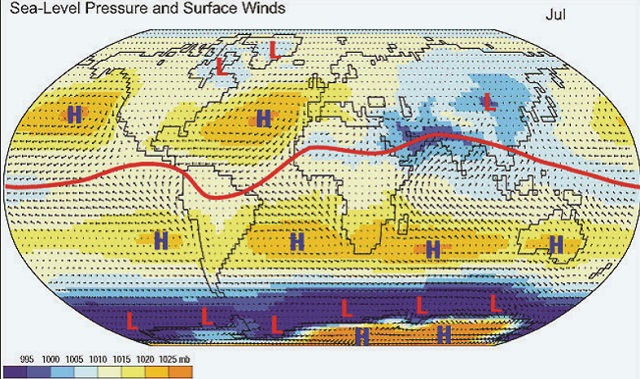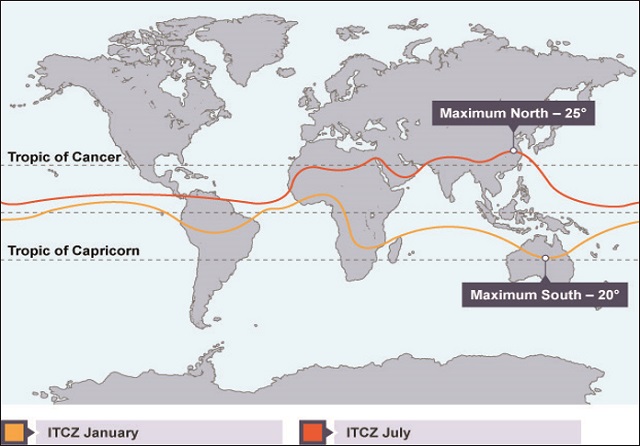
How combination of sun, pressure, and wind affects weather around you
Kampala, Uganda | RONALD MUSOKE | June and July have been chilly, with days having an unbearable mix of very cold weather, dry winds and a hazy mist in parts of southern Uganda, including Kampala. Meanwhile, northern Uganda, especially the central northern districts, has experienced rainfall.
Recent prolonged dry spells have led people, especially farmers, to fumble and panic at the slightest hint of weather cooling, which they associate with the onset of rains. So even farming communities in the southern sector of the country, where July is known for being a harvest season, have been asking whether the weather pattern has changed again and whether they should immediately get back in their gardens, plough, and plant crops.
And as has become the norm too, some experts have been attributing the “unusual weather conditions” to climate change.
According to Dr. Mary Goretti Kitutu, the minister of state for water and environment, “We are experiencing climatic changes, and as a result our weather has become erratic, and given that Uganda is a tropical country, weather systems can build up very quickly, and that is why we are being affected this way.”
She told The Independent that since Uganda is a tropical country, weather systems tend to build up very quickly and that is why the southern sector—a sizeable chunk of surface area below the equator—is being affected by the chilly weather.
Some other experts The Independent has talked to, however, were not so firm in describing the June-July weather as “unusual’.
Michael Ssekaayi Mbogga, a lecturer from Makerere University’s Centre for Climate Change Research and Innovations says the current cold weather has nothing to do with climate change.
“These are normal seasonal temperatures expected in East Africa; unless people have a short-term memory, the months of June and July are usually the coldest months in Uganda,” he says, “It is just that climate change is hyped; the current temperatures are nothing extraordinary.”
Godfrey Mujuni, the Manager, Data Centre at the Uganda National Meteorological Authority (UNMA) also told The Independent that local meteorologists have always recorded relatively low temperatures in July. Mujuni says, the dip in temperature begins in June and peaks in July.
“This has always been the case; it is just that people rarely follow what goes on in their environment. For us, we know that we have always measured low temperatures in the months of late June, July and the first few days of August,” he said.
Mujuni says, since July is normally dry, people have tended to associate it with hot temperatures. However, the truth is that for most of southern Uganda, it is dry and very cold especially in the early morning although at times it goes on the entire day.
“We normally call this our winter,” Mujuni told The Independent.
He says this is not unique to Uganda. In Kenya, and particularly Nairobi, the same happens. He says the wintry conditions start in May, June and peak in July. Mujuni says temperatures can sometimes drop to 5ᵒC.
What causes the chills?
Mujuni says the low temperatures experienced around this time, are as a result of southwesterly trade winds that normally come from southern Africa and blow northwards towards the East African region. These winds more often come along with cold air and deposit it into Kenya and Uganda, he says.
Mujuni says the cold air winds blow towards the East African region because the pressure systems in the southern hemisphere become stronger than those in the northern hemisphere around June to August. There are two major pressure systems from the southern tip of Africa. One system is called the St. Helena pressure system from the Atlantic Ocean and another the Mascarene from the Indian Ocean. These two push cold air upwards from southern Africa up north towards East Africa.
“Remember,” Mujuni said, “It is winter in the southern hemisphere and countries such as South Africa, Zimbabwe, Botswana and Namibia are experiencing winter right now.”
“This is the reason why it is very cold right now in Uganda and some parts of Kenya like Nairobi.”

Paul Isabirye, the Director Station Networks and Observation at UNMA told The Independent on July 15 that Ugandans may not notice it but, that is how the weather in Uganda’s southern parts has always been in the period starting June to August.
In Uganda and the equatorial region as a whole, the coldest months are normally those when the sun is at the farthest extreme from the equator, Isabirye says. For instance, since March, the sun has been moving from the Tropic of Cancer in the north towards the equator where it will be by September as it continues southwards to reach the Tropic of Capricorn by December.
The sun creates an area of high pressure wherever it is. Because the sun is currently in the Tropic of Cancer in the north of Africa, it has created very cold weather in the southern hemisphere and when it is over the Tropic of Capricorn (around December-January); it creates cold weather in the northern temperate regions of Europe. In both cases, Uganda and the East African region share the cold weather conditions.
The current hazy conditions, according to Mujuni, are caused by the St. Helena pressure system which originates from the Atlantic Ocean and then forces the southeasterly trade winds to pick dust from the Kalahari Desert and deposit it in the East African region.
Highs and lows
Mujuni said the whole country has generally had low temperatures during the last two months. For instance, the western district of Kabarole recorded the lowest mean minimum temperature of 9.3ᵒC in the country in June while the second coldest town has been Kabale in southwestern Uganda with an average minimum temperature of 11ᵒC.
Mbarara in southern Uganda recorded an average minimum temperature of 16.4ᵒC. In contrast, for the whole of June, the maximum temperature in the northwestern district of Arua which is famous for registering temperatures of close to 40ᵒC averaged 28.3ᵒC with the lowest maximum at 25ᵒC and the highest maximum at 30.5ᵒC.
In the northern town of Gulu, the weatherman recorded a mean of 30.2ᵒC with the lowest maximum standing at 27.7ᵒC and the highest maximum standing at 32.5ᵒC.
Kasese which is one of the hottest areas in Uganda because it is in the Rift Valley recorded a mean of 32.5ᵒC, with the lowest maximum being 27.5ᵒC and the highest maximum standing at 34.6ᵒC.
For Soroti, in eastern Uganda, the average stood at 29.7ᵒC with the lowest maximum standing at 26.2ᵒC and the highest maximum standing at 31.8ᵒC.
Interestingly, Gladys Mirembe, the environment officer of Fort Portal Municipality notes that although Kabarole District is cold at the moment, it is not as cold as the town used to be in the 1990s.
“It used to be like winter,” she says, “If you, for instance, left water outside the house and wanted to use it in the morning for bathing, your fingers would feel too cold to the point of paralysis.”
For decades, Kabarole’s cooler climate has been influenced by the equatorial forests (Mpanga and Kibaale), wetlands and the Rwenzori Mountains which lurk in the backdrop of the western town but the forests and wetlands are fast disappearing.
Alfred Ahimbisibwe, the Municipal Environment Officer for Kabale told The Independent on July 14 that the months of June, July and August are usually the coldest in this southwestern town.
Kabale is famous for being the coldest place in Uganda and has the affable moniker of “Switzerland of Africa.”
Ahimbisibwe says during the other months, the fog clears at around 8:30am and the sun comes out but in the cold months, Ahimbisibwe says, the sun might come out at 7:30am but the coldness persists up to around midday.
Off season rainfall episodes
The seasonal rainfall outlook for the June-August period released on May 30 by UNMA predicted dry conditions over most parts of southwestern and central Uganda, the Lake Victoria basin, and some parts of eastern Uganda.
The UNMA officials say the current rains occurring in parts of southern Uganda are what they refer to as “off-season” rains. These are not able to support agriculture and therefore should not excite farmers to start planting.
Mujuni told The Independent that the few rainfall episodes that have been recorded around the Lake Victoria crescent, parts of the south-western, central, parts of eastern Uganda are due to the intensification of the cold Mascarene (pressure system) which have been carrying some moisture into the region.
“Sometimes the pressure systems in the Oceans gain strength and pick moisture from the oceans which they deposit around our region,” he says.
The north has different rainfall seasons. So the rains falling in the central northern Uganda districts of Gulu, Apac, Pader, Nwoya, Amuru, Oyam and Kiryandongo — are part of the typical rainfall season there.
The rainfall in northern Uganda should support agricultural activities, according to Mujuni, but farmers in the southern sector need to wait for the more dependable or stable rains expected in mid-August and September before they resume agricultural activities.
****
 The Independent Uganda: You get the Truth we Pay the Price
The Independent Uganda: You get the Truth we Pay the Price




What is unusual with July weather is the rain received in some parts around lake Victoria, which is higher than normal. Otherwise temperatures are within range. What does not make it strange is that the seasonal forecasts from the Uganda National Meteorological Authority (UNMA) that came out earlier this year, already pointed us in this direction. We ought to have been prepared.
The message to the public should be that, we cannot for sure know how climate change will unfold. Projections indicate increase in temperatures with unchanged, slightly reduced or increased rainfall totals. Rainfall totals are meaningless to rain-fed agriculture which also depends on the reliability of that rainfall, to come at the right time and in the right amounts. And we know this is not normally the case. Thus water harvesting, micro or even mega irrigation projects are no longer luxuries for the rich countries. These coupled with sound land management, value addition for farm produce and effective and efficient information and knowledge dissemination are options that will help our communities improve production and productivity as well as deal with impacts of climate change.